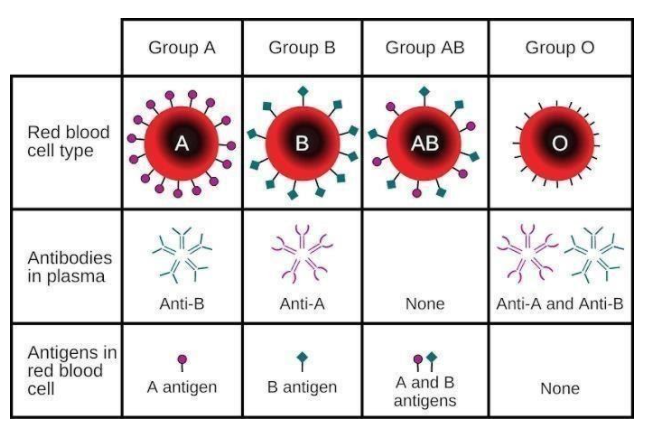
The possible blood groups of the offspring of the parents with blood group O and AB are
(А) O, A, B and AB
(B) A, B and AB
(С) A and B
(D) O and AB
Answer
547.5k+ views
Hint: Mendel also conducted artificial pollination or cross-pollination experiments using several true-breeding pea lines. In this case, the alleles show codominance.
Complete answer: Mendel selected a total of 14 true-breeding pea varieties. He selected 7 characters, some of them include seed shape, seed colour, pod colour, etc. Mendel crossed pea plants, for instance, stem height and crossed with tall and dwarf plants and got a ration 3:1, but some inheritance differs from this ratio as:

Codominance:
ABO blood type is an ideal example of co-dominance. For ABO blood group system of blood groups, allele A produces N-acetylgalactosamyl transferase enzyme which recognises H antigen present in RBC membrane and adds N-acetylgalactosamine to sugar a part of H antigen to make A antigen. The allele IB produces galactosyl transferase enzyme which adds galactose to sugar a part of H-antigen to make B antigen. Alleles 14 and 15 produce a rather different sort of sugar, while allele i don’t produce any sugar or antigen. IA and i are completely dominant over i, in other words when IA and i are known to occur only if IA expresses, as i don’t produce any sugar, and when IB and i are present, only 1B expresses. When both IA and i are present, both enzymes or sugars both antigens A and B are produced, which is often due to codominance. These antigens determine the sort of blood type. Blood type A has antigen A, B has antigen B, AB has both antigens, while blood type O doesn't carry any antigen. So, the child can have blood type A or B which differs from parents.
Hence, the correct answer is option C.
Note: Besides incomplete dominance, certain alleles show codominance. Here in $\mathop F\nolimits_1 $ hybrid, both alleles express themselves equally and there is no mixing of the effect of both alleles, therefore, the hybrid progeny ($\mathop F\nolimits_1 $) resembles both the parents.
Complete answer: Mendel selected a total of 14 true-breeding pea varieties. He selected 7 characters, some of them include seed shape, seed colour, pod colour, etc. Mendel crossed pea plants, for instance, stem height and crossed with tall and dwarf plants and got a ration 3:1, but some inheritance differs from this ratio as:

Codominance:
ABO blood type is an ideal example of co-dominance. For ABO blood group system of blood groups, allele A produces N-acetylgalactosamyl transferase enzyme which recognises H antigen present in RBC membrane and adds N-acetylgalactosamine to sugar a part of H antigen to make A antigen. The allele IB produces galactosyl transferase enzyme which adds galactose to sugar a part of H-antigen to make B antigen. Alleles 14 and 15 produce a rather different sort of sugar, while allele i don’t produce any sugar or antigen. IA and i are completely dominant over i, in other words when IA and i are known to occur only if IA expresses, as i don’t produce any sugar, and when IB and i are present, only 1B expresses. When both IA and i are present, both enzymes or sugars both antigens A and B are produced, which is often due to codominance. These antigens determine the sort of blood type. Blood type A has antigen A, B has antigen B, AB has both antigens, while blood type O doesn't carry any antigen. So, the child can have blood type A or B which differs from parents.
Hence, the correct answer is option C.
Note: Besides incomplete dominance, certain alleles show codominance. Here in $\mathop F\nolimits_1 $ hybrid, both alleles express themselves equally and there is no mixing of the effect of both alleles, therefore, the hybrid progeny ($\mathop F\nolimits_1 $) resembles both the parents.
Recently Updated Pages
A man running at a speed 5 ms is viewed in the side class 12 physics CBSE

State and explain Hardy Weinbergs Principle class 12 biology CBSE

Which of the following statements is wrong a Amnion class 12 biology CBSE

Two Planoconcave lenses 1 and 2 of glass of refractive class 12 physics CBSE

The compound 2 methyl 2 butene on reaction with NaIO4 class 12 chemistry CBSE

Bacterial cell wall is made up of A Cellulose B Hemicellulose class 12 biology CBSE

Trending doubts
What are the major means of transport Explain each class 12 social science CBSE

Which are the Top 10 Largest Countries of the World?

Draw a labelled sketch of the human eye class 12 physics CBSE

Explain sex determination in humans with line diag class 12 biology CBSE

The pH of the pancreatic juice is A 64 B 86 C 120 D class 12 biology CBSE

Give 10 examples of unisexual and bisexual flowers




